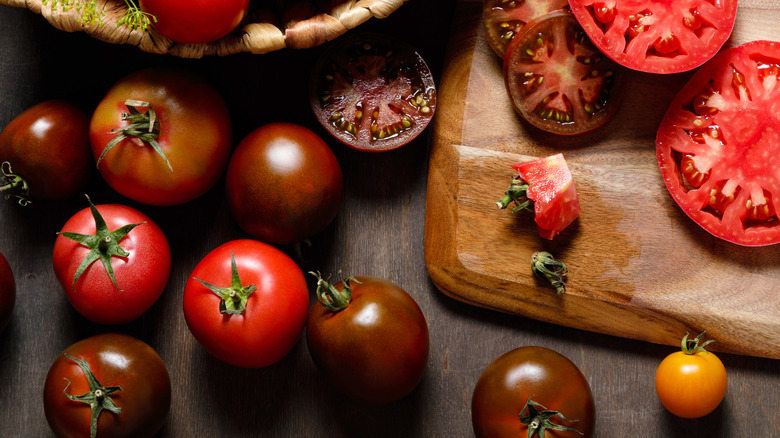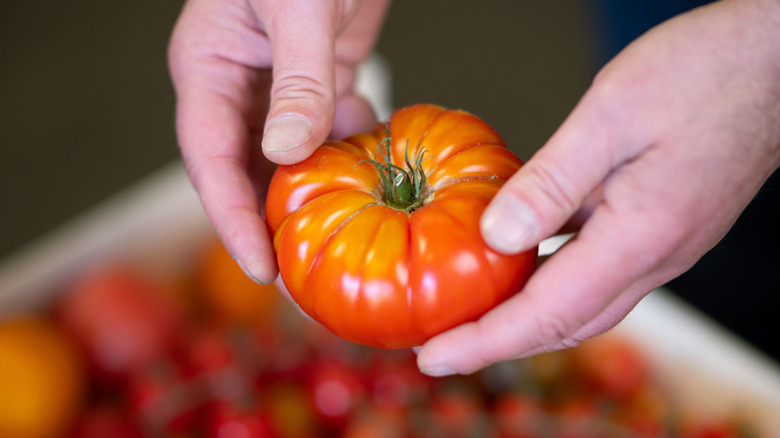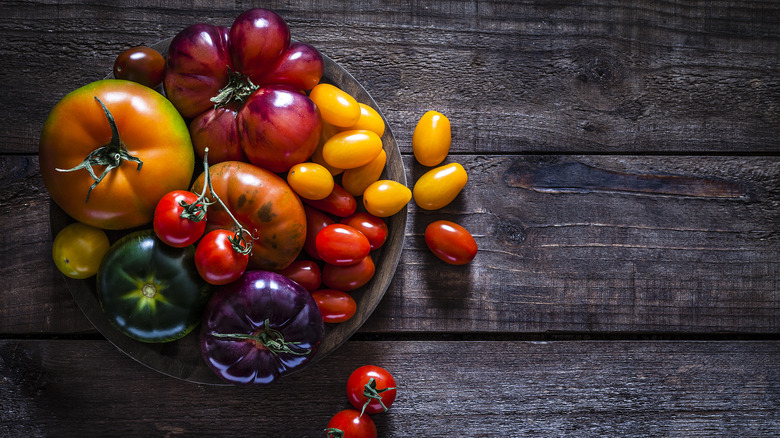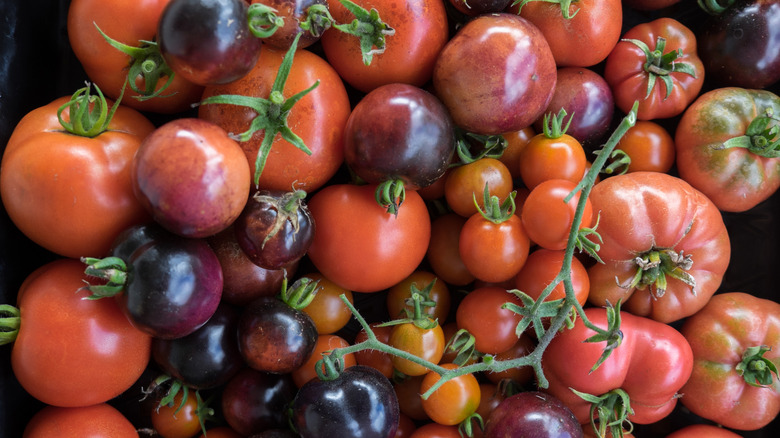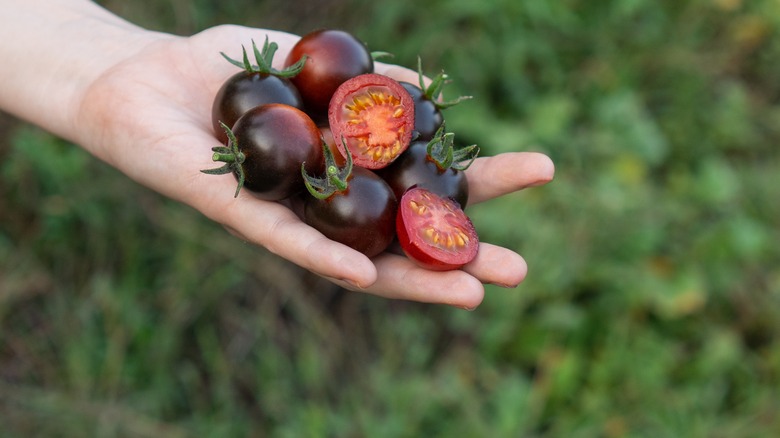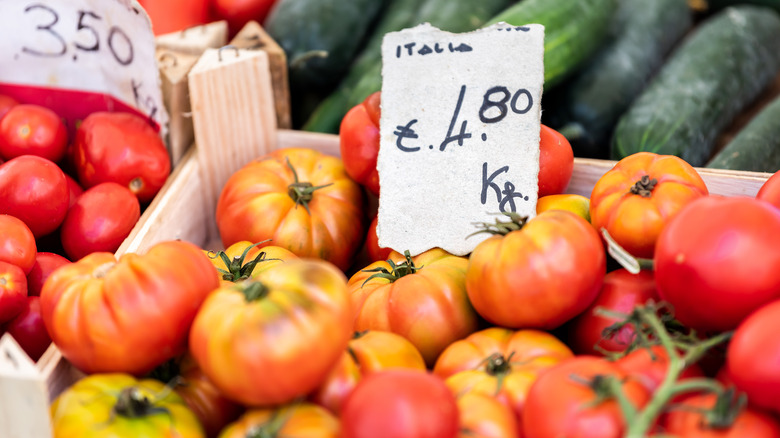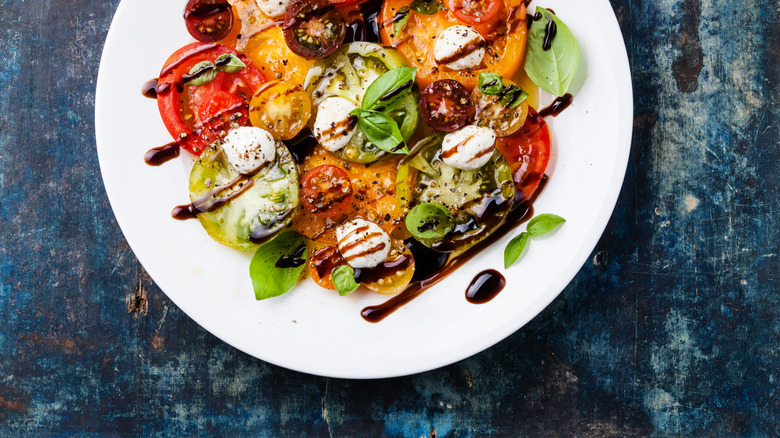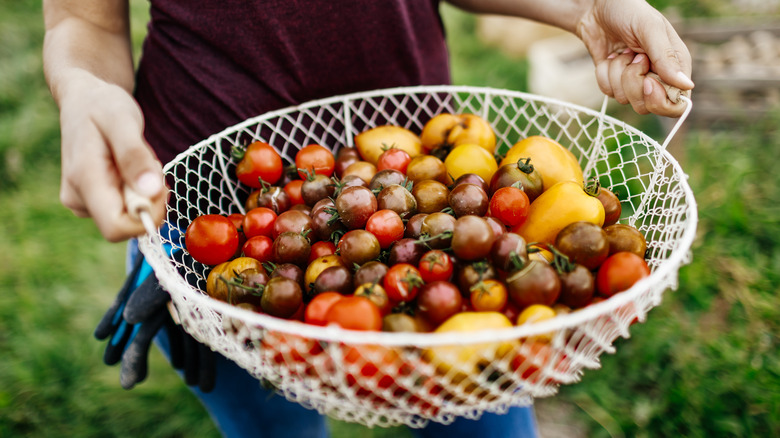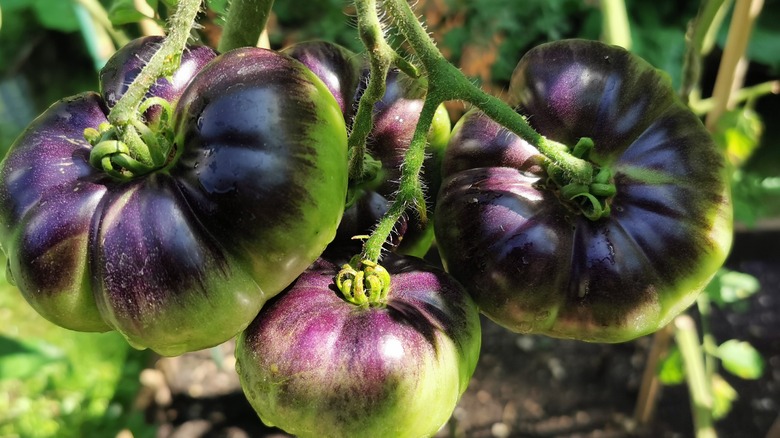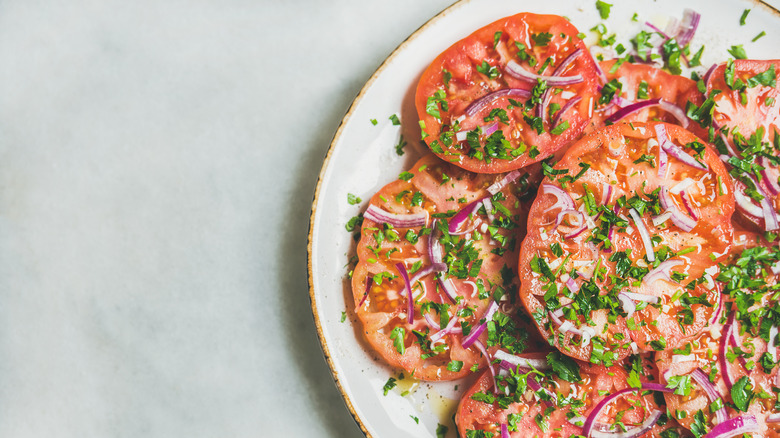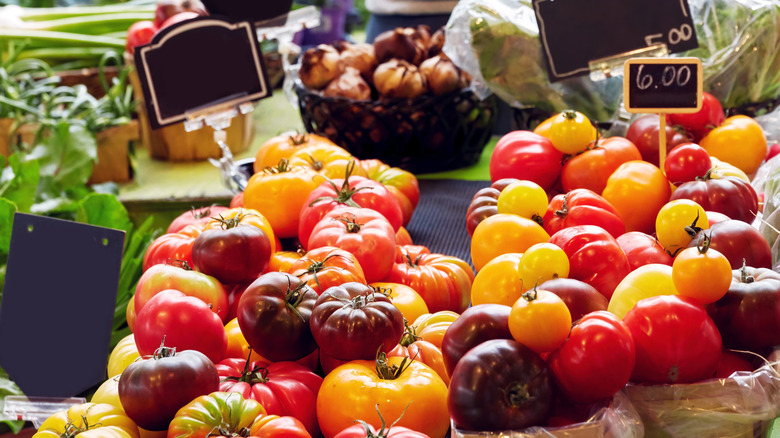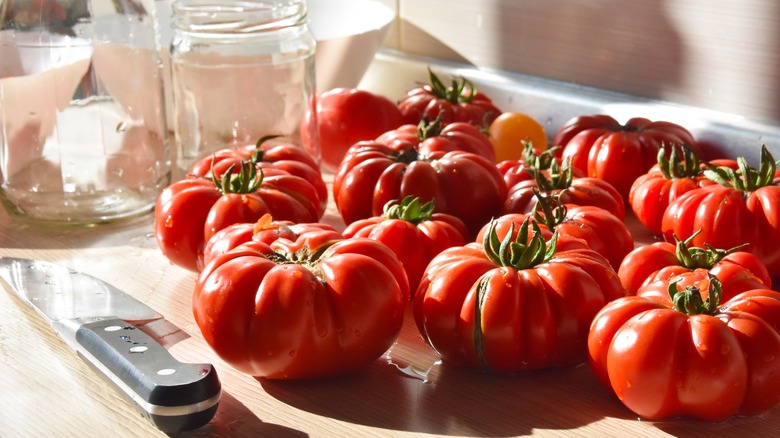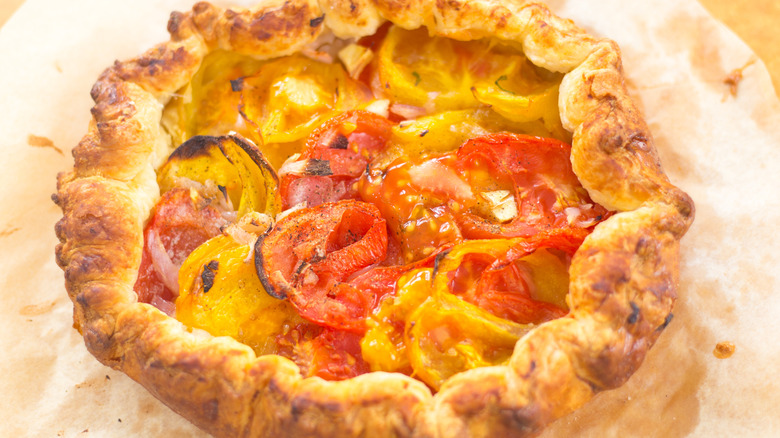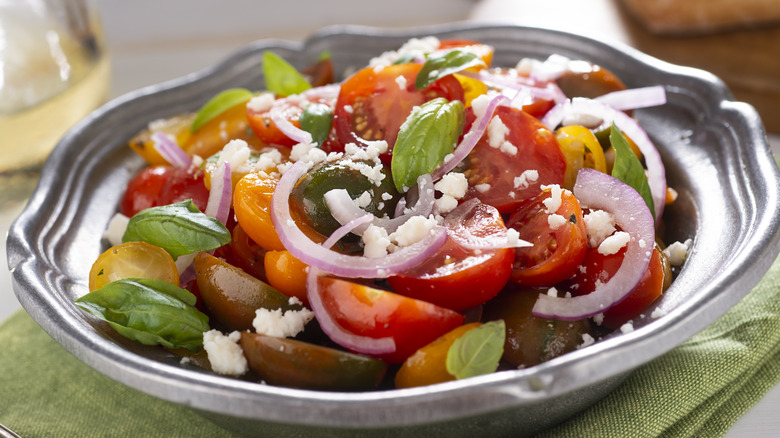What Is An Heirloom Tomato?
Have you ever been caught off guard by how beautiful some types of produce are? It's how we feel whenever we see an heirloom tomato sitting in a basket at the farmer's market. The tomato is practically saying, "Pick me, pick me!" And with a vibrant purple hue or remarkable orange stripes with a distinct, vegetal aroma, how can you say no to it?
Heirloom tomatoes aren't just pretty to look at, but they're also a utilitarian type of tomato to keep in your kitchen. But how much do you really know about this exciting tomato? We're answering the most commonly asked questions about this fruit and how to make the most of it when you find it at your local market or in your garden. After all, this isn't just any boring type of tomato. It might just become a new focal point for your kitchen and cooking repertoire.
What is an heirloom tomato?
Heirloom tomatoes are different from other types of tomatoes you'll find at the grocery store or a farmer's market. These tomatoes have three primary characteristics that distinguish them from other tomato varieties. The first is that the tomatoes are open-pollinated, which means the "mother" plant will produce seeds that can be saved and are an almost exact genetic match. Open pollination can occur via pollinators like bees and butterflies, wind, or the grower. It's important to note that all heirlooms are open-pollinated, but not all open-pollinated tomatoes are considered heirlooms. True heirlooms must be "old" because they have been a variety for anywhere between 25 and 50 years. The seeds, like furniture or jewelry, must also be passed down from generation to generation.
There is no exact blueprint for the color and shape of an heirloom tomato, so long as it meets the three characteristics. There are over 100 different types of heirloom tomatoes in the United States and an estimated 3,000 globally, which are suitable for very different climates and growing regions. Moreover, there are four main groupings of heirloom tomatoes: commercial (bred for at least 50 years via open pollination), family heirlooms, created heirlooms (intentional crosses), and mystery heirlooms (produced via natural cross-pollination).
How heirloom tomatoes got their name
Heirloom tomatoes got their name because they were passed down from generation to generation, like an heirloom piece of jewelry. Early generations of farmers selected tomato varieties based on a specific goal, such as bigger tomatoes or ones with a certain flavor. When the next generation receives those seeds, the tomatoes have been selectively bred for that characteristic. This is why heirloom tomatoes are especially large, and colorful, or have unique traits not shared by your average beefsteak tomato.
You can find heirloom seed varieties at seed exchanges or swaps if your community doesn't have a generational system of passing down seeds. These events allow farmers to pick up new varieties (some of which are up to 200 years old) or ones that have a specific desirable characteristic. Thanks to innovations in shipping and agricultural sales, you can also order heirloom seeds from a distributor and have them shipped to your doorstep.
The difference between a heirloom tomato and a hybrid tomato
Most of the tomatoes you find at the store are hybrid tomatoes — not heirlooms. A hybrid tomato results from breeding two plants together for a select trait, like high yield, better disease resistance, or thick skin. For the most part, these hybrid tomatoes are not genetically modified, meaning that the breeder did not alter the plant's genetics. Heirloom tomatoes are also not genetically modified. The only instance that these tomatoes would become genetically modified would be if a genetically-modified tomato were introduced (either intentionally or unintentionally, like by wind pollination) and bred to those plants.
There are some drawbacks to selectively breeding tomatoes for a particular characteristic. For example, suppose a farmer is selecting a variety for disease resistance. In that case, the subsequent generations of the tomato will also be disease resistant but may lack in other areas like flavor. It's why many heirloom varieties are noticeably sweeter and more flavorful than hybrid tomatoes.
History of the heirloom tomato
Heirloom tomatoes and the reason why people started collecting them are exciting and integral parts of the food's history. The tomato itself is endemic to Mexico and Central America, where it was cultivated by the Aztec and Incan people as early as the seventh century. But it took until the 19th century that the tomato became popular in American kitchens. When new tomato varieties became popular, the older varieties tended to phase out of production. Research shared by the University of California Cooperative Extension suggests 80% of all tomato varieties were extinct by 1910. Farmers started keeping many of these seeds to preserve them.
After World War II, hybridized tomato varieties dominated because they could be easily shipped from growing regions to supermarkets. These hybridized varieties had thick skins that prevented them from getting damaged, while their standard color shined as a feature of a true, indistinguishable commodity — meaning that one beefsteak tomato looked the same as the next one. However, the selective breeding of these varieties costs the tomato its authentic flavor.
Heirloom varieties have returned to the spotlight as farmers try to achieve a better tomato flavor. Now, new heirloom species are being introduced yearly via immigrants and growers seeking optimal flavor, color, and uniqueness.
Why are heirloom tomatoes more expensive than other tomatoes?
There are several reasons why consumers should expect to pay more for heirloom tomatoes than hybridized varieties. The first is that heirloom varieties produce a lower yield per acre than hybrid tomatoes — which is because hybrid tomatoes are selectively bred to withstand harsh growing conditions and produce more fruits per plant. Heirloom varieties are also not as disease-resistant as hybrid tomatoes, meaning that farmers can expect more of the heirlooms to die before reaching the market.
Heirloom tomatoes are so expensive because farmers must dedicate more resources to carefully harvesting the fragile fruits. Hardy varieties can be mechanically harvested and packaged, while heirlooms must be picked by hand, which increases labor costs, or harvested mechanically with the notion that a percentage of the tomatoes will be lost. As a result, the market price for heirloom varieties is more than hybridized tomatoes.
What an heirloom tomato tastes like
Not all heirloom tomatoes taste the same because the class has immense genetic diversity. Overall, heirloom tomatoes are sweeter than other types, with more organic notes and flavor that's, well, tomato-y.
It's important to remember that there is no correlation between an heirloom tomato's color and its flavor. Some tomatoes will be tart, others sweet, and some more intense than others. The Cherokee Purple, for example, has a deep, rich flavor with almost smokey notes. Black cherry tomatoes, which are very small and have a mysterious shade of mahogany brown, have a complex flavor perfect for snacking or making into a pasta sauce.
Regardless of which type of heirloom you pick, you should try to pick tomatoes that are half-ripe — meaning they are still somewhat hard and not at their flavor apex. This is because letting the tomatoes sit on the vine for too long makes them more susceptible to getting eaten by insects or cracking. Once you get your tomatoes, leave them on the counter at room temperature for a few days until they are ripe and ready to enjoy.
The varieties of heirloom tomatoes
It is hard to document the difference between every type of heirloom tomato because there are so many — but as with all produce, some varieties are much more well-known than others. One of these notable varieties is the Brandywine, which has a similar shape as the beefsteak tomato with pumpkin-like ridges on its sides. You can buy Brandywine in multiple colors, including black, red, and pink. The Green Zebra cultivar has a green hue with light yellow stripes; its tangy flavor is best used for fried green tomatoes.
The La Carotina variety gets its name from its carrot-like orange color and slight carrot flavor. Its peachy orange flesh has a slightly citrusy tang to it, which is perfect for freshening up a light summer salad. If you want a low-acid tomato with a predominately sweet taste, try Taxi tomatoes sliced up on your next sandwich.
How are heirloom tomatoes helping the environment?
Heirloom tomatoes serve an essential ecological function that isn't shared by other produce types: sustaining genetic diversity. The crops are more resilient to disturbances because these plants are often selected for characteristics related to a specific environment, such as pest tolerance or heartiness. In comparison, hybrid tomatoes are more susceptible to disease and crop failure because there is very little genetic diversity present. Planting heirloom crops regenerates the seed stock, which develops a more diverse gene pool — both in terms of taste and resiliency.
Some heirloom varieties require less chemical inputs than conventional types. The Mighty Mato, for example, is bred for disease resistance and thus requires little application of synthetic pesticides. These pesticides can potentially cause pesticide resistance, meaning that the evolved pest stops responding to the chemical. The synthetics also require significant amounts of energy to produce and may be toxic to farm workers.
Are heirloom tomatoes nutritious?
All tomatoes are highly nutritious. The fruit is rich in vitamin C and contains high levels of folate. Tomatoes are also low in calories because they are made up of mostly water; one 6-ounce tomato has about 26 calories.
Heirloom tomatoes also contain an important antioxidant called lycopene. Lycopene has been shown to protect the skin from harmful ultraviolet (UV) radiation from the sun and relieve the oxidative stress of diseases like diabetes. Consuming tomatoes with a source of fat, like olive oil, can help increase the body's absorption of this nutrient. Heirlooms also contain high amounts of potassium, which helps the body's cells maintain proper hydration. In addition, this mineral helps the muscles contract and supports healthy blood pressure. There's no evidence of a nutritional difference between heirloom tomatoes and other types. In short, there's no reason why you shouldn't be eating any tomatoes — especially flavorful heirloom varieties.
Where to buy heirloom tomatoes
Because heirloom varieties are often produced on smaller scales than conventional tomato varieties, like the Roma or Beefsteak, they are often more difficult to find. Your best bet to find them is to search around at a local farmer's market. Vendors may offer an array of heirloom tomato varieties, all varying in flavor, color, and size. If you are unfamiliar with a particular type of tomato, you can ask the vendor to describe its flavor and how best to use it in the kitchen.
If you see heirloom tomatoes in your local grocery store, it is likely because it's the tomato's peak harvest season. Since heirloom tomatoes don't ship well, many producers will only sell to retailers when the fruit is plentiful. This may mean your tomato is traveling a shorter distance from the grower to your plate. Check out your local grocery store for heirloom tomatoes in the late summer to early fall.
Store heirloom tomatoes properly
Heirloom tomatoes are finicky to store, so you have to take extra due diligence to keep your fruit as fresh as possible. The best way to keep tomatoes fresh is to put them on your counter — never in the refrigerator. Remove the stem of the tomato and place it stem-side down on a flat surface, such as a countertop. It can take several days for your tomatoes to ripen, depending on how firm they were when you bought them.
The countertop method will last you about a week. For optimal flavor and to avoid eating mushy tomatoes, be sure to eat them as soon as they are ripe. If you want to extend the shelf life of a just-ripe tomato, place it in your refrigerator. However, this method won't save super-ripe tomatoes from perishing, so be sure you keep an eye on your fruit to avoid biting into something rotten.
Cooking with heirloom tomatoes
Heirloom tomatoes are incredibly versatile and are featured in all kinds of recipes and cooking techniques. For example, you can make heirloom tomato sauce to preserve the flavors of summer all year. Start by cutting an X atop the tomato and submerge the fruit in boiling water for about 45 seconds. Then, quickly transfer it to an ice bath to help encourage the skin to peel off the tomato easily.
Once you've removed the skin with a knife, chop up your tomatoes and use them as you normally would in your favorite tomato sauce recipe. You can also bake heirloom tomatoes into recipes like our heirloom tomato and ricotta tart; baking the fruit causes it to wilt slightly and infuse bright tomato flavor into the rest of your cheesy tart. One of the most popular ways to prepare heirloom tomatoes is to eat them fresh — either as slices in a sandwich or sliced up into a salad.
What kind of recipes can you make with heirloom tomatoes?
The world is your oyster when it comes to making recipes with heirloom tomatoes. One of the easiest ways to preserve the fruit's unique flavor and color is to leave it uncooked for an heirloom tomato panzanella salad. Your tomatoes will be the star of the dish and complement the cubed pieces of bread, crunchy cucumber, herby dill and basil, and vinaigrette dressing. Play with different colors and sizes of fruit for an aesthetically compelling side dish or starter. It's refreshing and a light addition to any summery gathering.
You can also turn on your oven for an heirloom tomato galette recipe. It's made with plum tomato jam, but you can always substitute your favorite heirloom tomato variety instead. When picking your heirloom tomatoes for the top of the galette, try large tomatoes like Cherokee Purples or Brandywines; they're much easier to cut than the tiny cherry-tomato-sized fruits.
